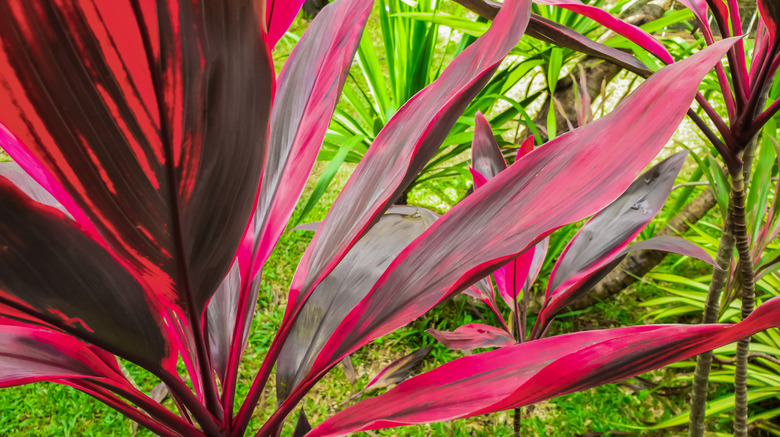How To Care For A Hawaiian Ti Red Sister Plant
We may receive a commission on purchases made from links.
Hawaiian ti plant (Cordyline fruticosa, formerly C. terminalis) comes in a wide variety of colors or color combinations across 20 species and dozens of cultivars. C. fruticosa 'Red Sister' (USDA plant hardiness zones 10 through 12) is one widely available cultivar, whose name comes from its deep-pink, burgundy-splashed foliage. Red Sister is grown as an outdoor landscape plant in subtropical and tropical areas and is a prized houseplant in cooler climates. Given the proper conditions and care and protected from temperatures below 55 degrees Fahrenheit, a Red Sister cordyline can grow to be a large plant that can bring a splash of color to any indoor or outdoor space.
Outdoor Planting and Care
1. Pick the Right Location
Choose a location in bright light, but avoid planting your Red Sister in full sun, as the leaves may burn. An eastern or southern exposure is optimal, but semishade is acceptable. The more light, the more colorful the foliage will be.
2. Prep for Planting
Remove your ti plant from its original container and loosen its roots. Dig a hole twice the diameter of the plant's container and 3 inches deeper. Add 3 inches of compost to the bottom of the hole.
3. Plant Red Sister
Place the plant in the hole and fill the hole with water. While the water is soaking in, start alternately adding the original soil with the compost in approximately 2-inch-thick layers. Add more water as necessary. Adding the soil and compost while the water is in the hole helps the soil settle and prevents air pockets. Backfill the hole with soil taken out of the hole. Tamp the soil down well around the plant.
4. Fertilize Twice Annually
Fertilize with a slow-release fertilizer containing minor elements twice a year, in early spring and late summer.
5. Manage Pests and Diseases
Check regularly for pests, such as spider mites and mealybugs, and treat by spraying the upper and lower leaf surfaces with insecticidal soap, according to label directions. Check for signs of fungal diseases, like leaf spot and blight, and treat with a natural fungicide, such as liquid copper or neem oil, according to label directions. Spray plants only in the early morning or evening hours when it's cooler to avoid burning the leaves.
6. Water Your Plant Carefully
During its first growing season, water your newly planted ti plant enough to keep the soil consistently damp, but not so much that it's sopping wet. Once the plant is established, it's drought tolerant and likely won't need supplemental watering.
7. Provide Winter Protection
Protect your ti plant from freezing temperatures by covering it with a blanket tied around the base of the plant. Do not cut back cold-damaged limbs until new growth comes out in the spring.
Indoor Planting and Care
1. Plant Red Sister
Plant your Red Sister ti plant in fast-draining potting mix in a sturdy plastic container with drainage holes. Look for a container that's at least 2 inches wider than your plant's nursery pot. Place the plant in a brightly lit eastern- or southern-facing window.
2. Fertilize and Water
Mix all-purpose slow-release fertilizer pellets into the top inch of the potting mix at the rate of 1 teaspoon per gallon of pot size. Water the plant thoroughly after planting and when the top 2 inches of the potting mix feel dry.
3. Manage Pests and Diseases
Help prevent spider mite infestations in dry indoor air by misting your plant several times daily or placing it in a pebble-filled tray that's half full of water to provide humidity. See Step 5 above for additional instructions on controlling pests and diseases.
4. Move Your Plant Outside
Place your Red Sister ti plant in semishade outdoors in the summer if desired. Protect it from freezing temperatures by bringing it indoors.
Warning
You may want to think twice about bringing home a Red Sister ti plant if you live with a dog or cat as C. fruiticosa is toxic to both. If you think your pet may have ingested Red Sister plant material or any other toxic substance, call your veterinarian or the ASPCA Animal Poison Control Center at (888) 426-4435 as soon as possible.
Red Sister Ti Plant Care
Red Sister Ti Plant Care
You can spiff up a Red Sister cordyline that's developed issues like legginess, brown leaf tips, or leaf drop:
- Your Red Sister ti plant will eventually become leggy. Use clean, sharp pruning shears to cut your plant back and stick the cuttings into the ground or container around the plant. They root easily and will provide foliage while the bare limbs are starting to put out new growth.
- Ti plants are sensitive to chlorine, so let chlorinated water sit out for 24 hours before watering to avoid brown leaf tips. You can trim brown tips and edges from leaves to make them more attractive.
- Bottom leaves will die and fall off as the plant grows, but it's safe to remove them. To get your ti plant to branch more, cut an inverted triangle into the stem, removing the top layer of bark. In a few weeks, a branch will grow from the tip of the triangle.
